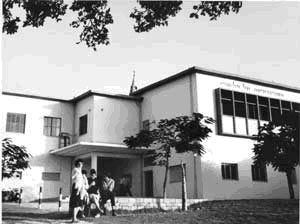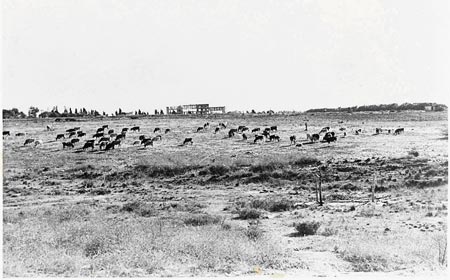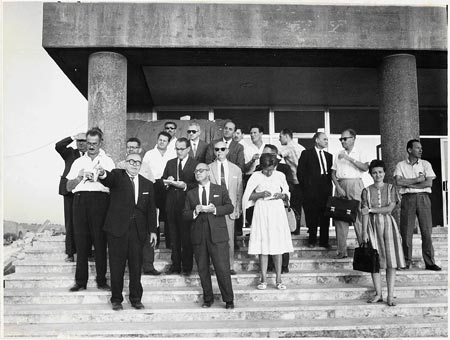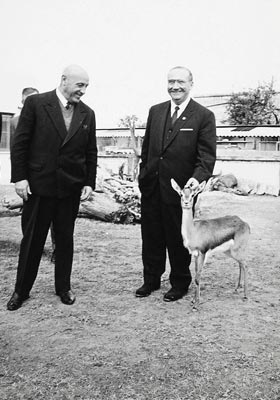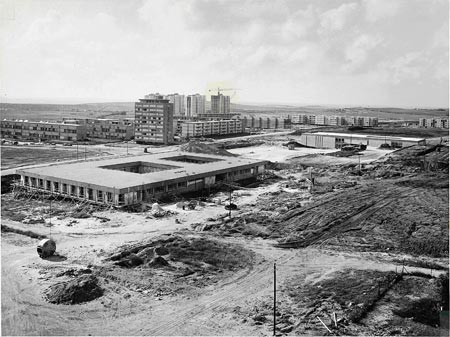 | |||||||||||||||||
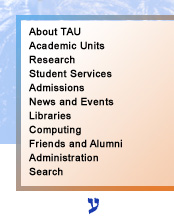 |
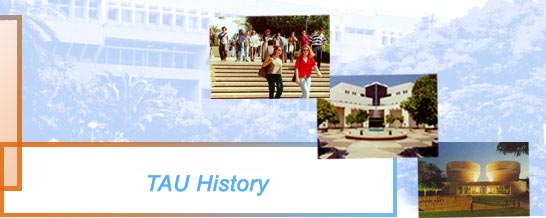 |
||||||||||||||||
The Making of a University Tel Aviv University came into being through the dedicated efforts of visionaries who foresaw the need for an additional university in Israel’s rapidly growing central region. In the 1930s, the idea was promoted by then mayor of Tel Aviv, Meir Dizengoff, with whose encouragement two post-secondary education facilities were opened during the British Mandate period: The Biological-Pedagogical Institute and the School of Law and Economics.
1950’s: The Early Years
Mayor of Tel Aviv Haim Levanon at the opening ceremony for the first year of study at the Biological-Pedagogical Institute, 1 December 1953.
Students examine their grades on the billboard of the Natural Sciences Institute, late 1950s. Looking back on those early years, TAU history professor Zvi Yavetz recalls how “as a young man who arrived at the miserable shacks of Abu Kabir from the splendor of the Jerusalem campus [the Hebrew University], I could only groan…These were awful years in terms of the physical conditions,” recalls Yavetz, “but I will never forget how students who were later to become great professors sat on first graders’ chairs... I was quite sure then, that with students like these, the authorities wouldn’t be able to ignore us for too long.”
The first campus at Abu Kabir In 1954 an additional institute was founded in Tel Aviv: the Academic Institute of Jewish Studies. The University library was founded, new study tracks were opened, a teaching staff was formed, laboratories and classrooms were built on the Abu Kabir campus and an administration was established. In the 1955-1956 academic year, the two institutes had 130 students. Meanwhile, the cornerstone of the School of Law and Economics’ permanent home, the Trubowicz Building, was laid in Ramat Aviv in 1955. The building was constructed on a plot designated by the Tel Aviv Municipality as the site of a future university, with the encouragement of then Mayor of Tel Aviv Israel Rokach. Completed in 1959, it was the first building on what was to become the TAU campus, although the School initially became a branch of the Hebrew University of Jerusalem. With the determination of Dr. George Wise, the first President of Tel Aviv University, it became incorporated into Tel Aviv University in 1965.
The Trubowicz Building under construction, Ramat Aviv, 1955. In 1956, the Academic Institutes were officially upgraded into the new “University of Tel Aviv.”
Diploma ceremony at the Academy of Music, 1957-8. Chairing the ceremony was the second Honorary President of the Academy, composer and conductor Leonard Bernstein (standing, center) and its founder and Head, Odeon Partos (right), the principal violinist of the Israel Philharmonic Orchestra. The Academy was founded in 1945 and incorporated into Tel Aviv University in 1966. In 1960, the process of accreditation by the Council for Higher Education began. Six departments were authorized to grant a bachelor’s degree, and a seventh department (microbiology) was also authorized to grant a master’s degree.
President Yitzhak Ben-Zvi (center) lays the cornerstone for the Ramat Aviv campus, together with Mayor Mordechai Namir (to his right) In 1962, the Arieh and Rivka Shenkar Buildings of Chemistry and Physics were constructed on the Ramat Aviv campus. At the same time, architect Werner Witkover completed the first master plan for a modern, centralized campus that would include all the necessary academic, administrative and maintenance facilities.
Dr. George S. Wise (first from left, front row) shows journalists the new campus at the dedication of the Shenkar Building, October 1964. 1963 was another breakthrough year, with the founding of the Faculty for Continuing Medical Studies. In 1972, this was to become one of the schools of the Sackler Faculty of Medicine. On November 3, 1963, Dr. George. S. Wise became TAU’s first President. A manufacturer and entrepreneur in America and Mexico, Wise had served as Chairman of the Board of the Hebrew University until 1962, and was then persuaded by Prime Minister Levi Eshkol and Mordechai Namir to come on board.
Visit of Dr. George Wise (right) to the Zoological Gardens at Abu Kabir, 1962, accompanied by Mayor Mordechai Namir. Founded in 1933 by Yehuda Margolin and moved to the Ramat Aviv campus in 1981, the Gardens are today Israel’s largest and leading zoological research facility. Dr. Wise was given broad authority as President, enabling him to promote the University’s interests both on the academic and administrative levels. He directed the University, recruited outstanding new faculty members, represented it in the outside world, and coordinated all development and fund-raising activities. He leveraged his wide-ranging close relations with international heads of state to bolster confidence in the University and promote initiatives that had previously stalled due to budgetary difficulties. 1960s and 1970s: The University Expands On November 1969, the University received full accreditation from the Council for Higher Education, opened new faculties and moved to the new campus in Ramat Aviv under the direction of Dr. George Wise.
Photo showing the expansion of the campus with the Gilman Building under construction in the foreground and Ramat Aviv in the background The Physics Department was founded and immediately began to conduct scientific research at an international level, making their mark in the fields of nuclear research and astronomy. The Chemistry and Mathematics Departments also expanded and a younger generation of scientists began to emerge. They developed innovative fields that had not yet been studied at Israel’s other higher education institutions. During 1964, Dr. Wise launched a reorganization of the University’s governance structure. The Senate, which included all full professors and representatives of the associate professors, was formally encoded in the University constitution, the spheres of authority of the Rector and Deans were redefined, faculty councils were restructured, and the first Director-General, Dr. Yitzhak Hoffman, was appointed. On November 4, 1964, the Ramat Aviv campus was dedicated. The festive dedication ceremony was attended by President Zalman Shazar, Prime Minister Levi Eshkol, ministers, Knesset members, judges, scientists and other prominent figures, and was a major milestone in the history of the University. Indeed, it was the beginning of a new era, in which TAU achieved its goal of providing high-quality education to thousands of students – at this time it had 3,174 students. TAU had become a major player among Israel’s higher education institutions.
Dedication ceremony for the Ramat Aviv campus, November 4, 1964. From left: Finance Minister Pinhas Sapir; President Zalman Shazar; Dr. George Wise; Prime Minister Levi Eshkol; Mayor Mordechai Namir; Minister of Education Zalman Aran and Rector Ben-Zion Katz. In order to expand TAU’s financial base, Dr. Wise formed the International Board of Governors, which incorporated figures from the academic and business spheres. The Board convened for the first time in October 1967, embodying the public support and recognition that the University now enjoyed. In the early 1970s, the University opened two more faculties: Engineering and Arts. In 1972, Dr. George Wise completed his term as TAU President and was elected as the first Chancellor. The University now had nine faculties with 12,000 students. In 1973, TAU was well on its way to achieving the goals set by its founders. The University was now well established on its permanent campus, with scientific achievements, making it an internationally recognized institution. The University had successfully fought for its survival and turned dream into reality. The next thirty years were devoted to maintaining its high standards, developing its research and teaching facilities, expanding its community initiatives and enhancing the significant role it plays vis-á-vis Israeli society and the Jewish Diaspora.
All material and photographs for this article were provided by courtesy of the Archive for the History of Tel Aviv University, headed by Benny Haspel, under the supervision of Prof. Zvi Yavetz. Statistics were kindly provided by Edi Keren, Head of the University Registration Unit.
| |||||||||||||||||


